- 1National Laboratory of Solid State Microstructures and Department of Physics, Nanjing University, Nanjing, China
- 2Collaborative Innovation Center of Advanced Microstructures, Nanjing University, Nanjing, China
Recently, real topological phases protected by PT symmetry have been actively investigated. In two dimensions, the corresponding topological invariant is the Stiefel-Whitney number. A recent theoretical advance is that in the presence of the sublattice symmetry, the Stiefel-Whitney number can be equivalently formulated in terms of Takagi’s factorization. The topological invariant gives rise to a novel second-order topological insulator with odd PT-related pairs of corner zero modes. In this article, we review the elements of this novel second-order topological insulator, and demonstrate the essential physics by a simple model on the honeycomb lattice. Novelly, the higher-order topological boundary modes can not only be tuned by the parameters but also the geometric shape of the sample.
Introduction
The symmetry-protected topological phases, such as topological (crystalline) insulators (TIs) and superconductors (TSCs), have been one of the most active fields of physics during the last 15 years [1–9]. Based on the topological K theory, the topological band theory has been established to classify and characterize various topological states [10–12]. Symmetry plays an fundamental role in the classification of topological phases. Considering three discrete symmetries, namely time reversal
Remarkably, from the classification table, the symmetry class with
The topological invariant w2 gives rise to novel topological phases with extraordinary properties. In 3D, it characterizes a real Dirac semimetal, which can be transformed into a nodal ring with symmetry-preserving perturbations. Then, the nodal ring is characterized by two topological charges (w1, w2). In 2D, it describes a topological insulator. The common topological wisdom is that the bulk topological invariant determines a unique form of the boundary modes, namely the well-known one-to-one bulk-boundary correspondence. However, a remarkable discovery in Ref. [41] is that w2 corresponds to multiple forms of boundary modes, extending the one-to-one correspondence to one-to-many. The 2D topological insulator can host various second-order phases with odd
As aforementioned, the second-order phases of the 2D topological insulator feature odd
In this article, we review the elements of 2D
The Honeycomb-Lattice Model
Let us start with presenting the honeycomb-lattice model, the lattice structure is shown in Figure 1A. The Hamiltonian in momentum space is given by
where
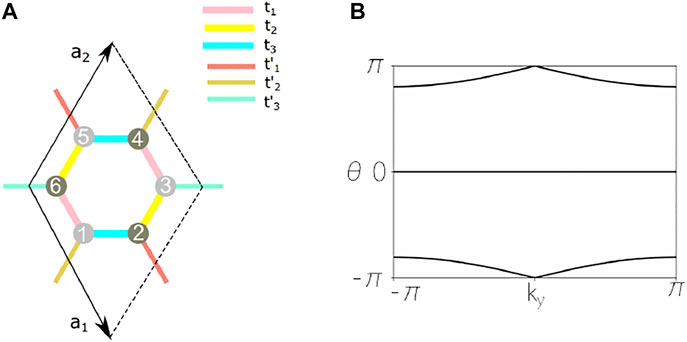
FIGURE 1. (A) Schematic of the honeycomb-lattice model. ti represents intracell hoppings and
To obtain the non-trivial topological phases, we calculate the determinant of the Hamiltonian (Eq. 1) at Γ point1 in the Brillouin zone as
Since the bulk topological criticality generally corresponds gap-closing point, we can obtain the topological phase-transition points by letting
Interestingly, if (Eq. 3) holds, the system is generally reduced to a topologically equivalent graphene model with two Dirac points in the first Brillouin zone [45]. When
Topological Invariants
The topology can be determined by various formulas of the topological invariant. We now briefly review them. First, as given in Ref. [22], the topological invariant can be determined by the Wilson loop
(with P indicating the path order) along large circles parametrized by kx.
Different from the conventional TIs and Chern insulators, the Wilson loop spectral flow for real phases are mirror symmetric with respect to the θ = 0 axis see Figure 1B. This is because
For honeycomb lattice with
As aforementioned, our system is protected by spacetime inversion symmetry
In general,
where
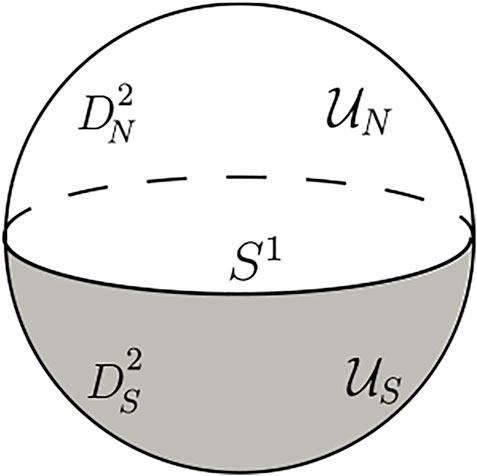
FIGURE 2. The Takagi factors in 2D.
The conduction and valence wavefunctions of
where n ∈ {1, 2, … , M}. φn = (0 0 ⋯ 0 1 0 0 ⋯ 0)T is a unit vector with “1” locating at the n-th position.
Performing a unitary transformation
Thus, we know the transition function
Physical Consequence
The high-order topological phase in the honeycomb model features novel bulk-boundary correspondence that is different from the traditional one, namely, it has one-to-many bulk-boundary correspondence. Furthermore, the boundary modes can be tuned by the boundary selection. According to analytical and numerical methods, we reveal that three pairs of hopping parameters ti and
where the subscript i denotes the hopping along the primitive vector ai direction (a3 = −a1 − a2). The above Eq. 10 can be derived from the boundary effective Hamiltonian2. Hence, if mi = 0, the corresponding edges are gapless, which is also the boundary critical condition to separate two second-order topological phases.
To demonstate the boundary modes, we consider a rhombic-shaped 2D sample with armchair termination, i.e., by opening boundary along a1 and a2 direction, as shown in Figure 3. If m1 = 0 and m2 ≠ 0, the helical edge modes along periodic a1 can be obtained, as shown in Figure 3B. However, once m1,2 ≠ 0, the helical edge modes will be gapped and the localized corner modes will emerge. More specifically, for the case with sgn(m1) = sgn(m2) (sgn(m1) = − sgn(m2)), the corner modes will locate at 120° (60°) corners, as shown in Figures 3A,C respectively. The
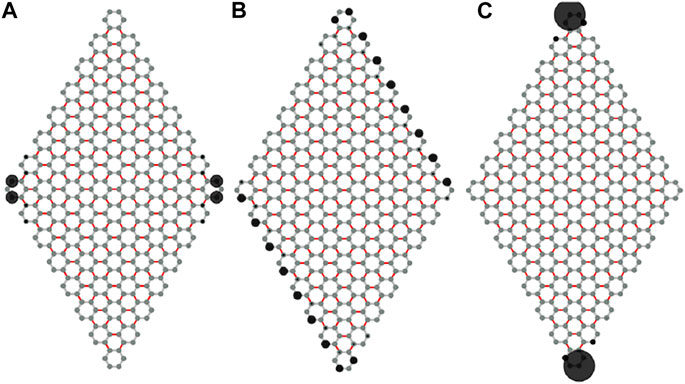
FIGURE 3. (A–C) Possible topological boundary modes for the rhombic-shaped sample with 10, ×, 10 unit cells. Black circles indicate the distribution of density of zero-mode (A,C) Second-order TI phases with a single pair of zero-modes corners in diagonal and off-diagonal (or horizontal and vertical) directions, respectively. (B) Helical edge modes with the boundary effective mass mi = 0, which is a critical state separating two second-order TI phases. Parameters are set as (A)
To keep the completeness of honeycomb unit cell in a rhomboid sample, one only has three kinds of armchair edges, namely the edge parallel to ai direction with i = 1, 2, 3. If the edge connected by the same corner has the same mass term mi sign, the corner zero-modes will be localized at the obtuse angle of the rhomboid, otherwise at acute corners. We shall theoretically explain these numerical results in the next section. It is emphasized that in the whole process of the edge-phase transitions, the bulk gap is always open and the symmetries are preserved, therefore, the bulk invariant ν is unchanged. Thus the conventional bulk-boundary correspondence is not appliable for TTI, namely, the bulk invariant can not uniquely determine the boundary modes, but dictates an edge criticality, as the concept mentioned in previous work [41].
As promised in introduction, we now proceed to tune the boundary modes with fixed parameters. In the rhombic case, all samples terminate with armchair edges and exhibit parameter-depended boundary modes. As long as
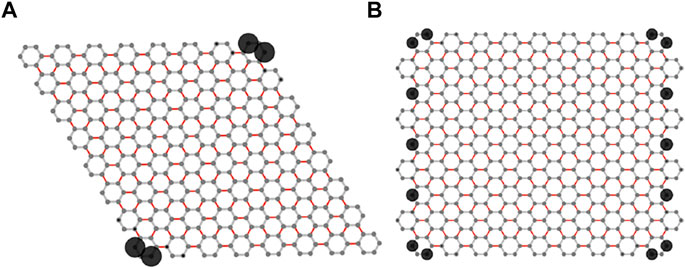
FIGURE 4. (A) Topological corner modes in rhombic sample with
Novelly, in both situations discussed above, for second-order topological phases, the number of the zero-energy corners must be odd pairs. For example, for a hexagonal sample, we can only find one or three pairs of zero-mode corners, as shown in Figures 5A,B. Similarly, the Octagonal sample also has one or three pairs of zero-mode corners as shown in Figures 5C,D.
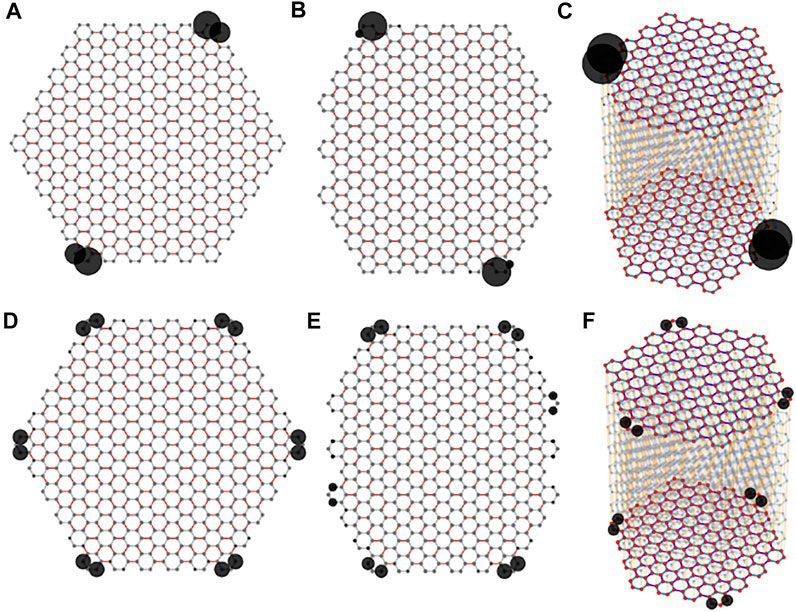
FIGURE 5. (A,D) Orthohexagonal sample with one and three pairs of zero-mode corners respectively. The parameters are set as
We find that the peculiarity of odd-pair-zero-modes is universal and it can be generalized to a higher-dimensional situation, such as 3D [44]. The 3D model is constructed by stacking the 2D honeycomb TTI discussed above in a staggered manner to preserve the sublattice symmetry
Analytic Method
We first proceed to solve the boundary criticality along the periodic a1 direction and openning boundary with a2. Replace
Following the same argument with aforementioned bulk criticality, we can obtain the boundary criticality by letting
The above Eq. 12 holds only at k ⋅a1 = 0. Thus, when the system is in a topological non-trivial case, Eq. 12 related edge criticality separates two different second-order topological phases with corner zero modes. Likely, we can obtain similar results for periodic a2 and a3 directions. For convenience, we can define boundary effective mass by the left of Eq. 12 for edges parallel to a1. Or, generally Eq. 10 for edges parallel to ai. Different from the armchair edges, the zigzag terminations has an additional boundary criticality, namely, the effective masses can be defined by
The derived details can be found in the Supplementary Appendix SAB.
With the effective mass orderly distributing on each edge (2), the existence of corner zero-modes is reduced to a Jackiw-Rebbi problem [46]. The corners with opposite effective masses on both sides can have zero-modes.
Discussion
In this article, we present a simple 2D realizable honeycomb-lattice model to demonstrate the essential physics of the Takagi topological insulator. It is found that with unchanged topological invariant, one can tune topological boundary modes by not only parameters, but also boundary selections. It goes beyond the common wisdom about bulk-boundary correspondence, and gives rise to much richer boundary physics.
Our model with novel physics is closely related to real systems. It is easier to realize our model by photonic/phononic crystals, electric-circuit arrays and mechanics systems, since only have nearest-neighbor hopping amplitudes are included into the model. Several special cases of our model have been recently realized in photonic/phononic crystals [47, 48], where hopefully the general form of our model can be further experimentally examined.
Author Contributions
All authors listed have made a substantial, direct, and intellectual contribution to the work and approved it for publication.
Funding
The authors acknowledge the support from the National Natural Science Foundation of China under Grants (Nos 11874201, 12174181, and 12161160315).
Conflict of Interest
The authors declare that the research was conducted in the absence of any commercial or financial relationships that could be construed as a potential conflict of interest.
Publisher’s Note
All claims expressed in this article are solely those of the authors and do not necessarily represent those of their affiliated organizations, or those of the publisher, the editors and the reviewers. Any product that may be evaluated in this article, or claim that may be made by its manufacturer, is not guaranteed or endorsed by the publisher.
Supplementary Material
The Supplementary Material for this article can be found online at: https://www.frontiersin.org/articles/10.3389/fphy.2022.915764/full#supplementary-material
Footnotes
1By the numerical calculation of Wilson loop, one can easily check that only the algebra of parameters obtained at Γ point is the real bulk criticality, while the others are not.
2Note that a pair of opposite edges parallel to ai have opposite mass terms since
3Finite-size effects can split the degenerate zero modes and deviate them from zero to form a ingap corner modes, but the deviation is exponentially suppressed with the sample size.
References
2. Hasan MZ, Kane CL. Colloquium: Topological Insulators. Rev. Mod. Phys. (2010) 82:3045–67. doi:10.1103/revmodphys.82.3045
3. Qi X-L, Zhang S-C. Topological Insulators and Superconductors. Rev. Mod. Phys. (2011) 83:1057–110. doi:10.1103/revmodphys.83.1057
4. Fu L. Topological Crystalline Insulators. Phys. Rev. Lett. (2011) 106:106802. doi:10.1103/physrevlett.106.106802
5. Chiu C-K, Teo JCY, Ascnyder AP, Ryu S. Rev. Mod. Phys. (2016) 88:035005. doi:10.1103/revmodphys.88.035005
6. Kruthoff J, de Boer J, van Wezel J, Kane CL, Slager R-J. Phys. Rev. X (2017) 7:041069. doi:10.1103/physrevx.7.041069
7. Benalcazar WA, Bernevig BA, Hughes TL. Electric Multipole Moments, Topological Multipole Moment Pumping, and Chiral Hinge States in Crystalline Insulators. Phys. Rev. B (2017) 96:245115. doi:10.1103/physrevb.96.245115
8. Liu F, Deng H-Y, Wakabayashi K. Phys. Rev. Lett. (2019) 122:086804. doi:10.1103/physrevlett.122.086804
9. Xie B, Wang H-X, Zhang X, Zhan P, Jiang J-H, Lu M, et al. Higher-order Band Topology. Nat. Rev. Phys. (2021) 3:520–32. doi:10.1038/s42254-021-00323-4
11. Kitaev A. Periodic Table for Topological Insulators and Superconductors. AIP Conf Proc (2010) 1134:22.
12. Schnyder AP, Ryu S, Furusaki A, Ludwig AWW. Classification of Topological Insulators and Superconductors in Three Spatial Dimensions. Phys. Rev. B (2008) 78:195125. doi:10.1103/physrevb.78.195125
13. Altland A, Zirnbauer MR. Nonstandard Symmetry Classes in Mesoscopic Normal-Superconducting Hybrid Structures. Phys. Rev. B (1997) 55:1142–61. doi:10.1103/physrevb.55.1142
14. Hořava P. Stability of Fermi Surfaces and K Theory. Phys. Rev. Lett. (2005) 95:016405. doi:10.1103/PhysRevLett.95.016405
15. Zhao YX, Wang ZD. Topological Connection between the Stability of Fermi Surfaces and Topological Insulators and Superconductors. Phys. Rev. B (2014) 89:075111. doi:10.1103/physrevb.89.075111
16. Ryu S, Schnyder AP, Furusaki A, Ludwig AWW. Topological Insulators and Superconductors: Tenfold Way and Dimensional Hierarchy. New J. Phys. (2010) 12:065010. doi:10.1088/1367-2630/12/6/065010
17. Matsuura S, Chang P-Y, Schnyder AP, Ryu S. Protected Boundary States in Gapless Topological Phases. New J. Phys. (2013) 15:065001. doi:10.1088/1367-2630/15/6/065001
18. Zhao YX, Wang ZD. Topological Classification and Stability of Fermi Surfaces. Phys. Rev. Lett. (2013) 110:240404. doi:10.1103/physrevlett.110.240404
19. Chiu C-K, Schnyder AP. Classification of Reflection-Symmetry-Protected Topological Semimetals and Nodal Superconductors. Phys. Rev. B (2014) 90:205136. doi:10.1103/physrevb.90.205136
20. Shiozaki K, Sato M. Topology of Crystalline Insulators and Superconductors. Phys. Rev. B (2014) 90:165114. doi:10.1103/physrevb.90.165114
21. Zhao YX, Schnyder AP, Wang ZD. Unified Theory ofPTandCPInvariant Topological Metals and Nodal Superconductors. Phys. Rev. Lett. (2016) 116:156402. doi:10.1103/physrevlett.116.156402
23. Ahn J, Park S, Yang B-J. Failure of Nielsen-Ninomiya Theorem and Fragile Topology in Two-Dimensional Systems with Space-Time Inversion Symmetry: Application to Twisted Bilayer Graphene at Magic Angle. Phys. Rev. X (2019) 9. doi:10.1103/PhysRevX.9.021013
24. Timm C, Schnyder AP, Agterberg DF, Brydon PMR. Inflated Nodes and Surface States in Superconducting Half-Heusler Compounds. Phys. Rev. B (2017) 96:094526. doi:10.1103/physrevb.96.094526
25. Yu T, Kennes DM, Rubio A, Sentef MA. Nematicity Arising from a Chiral Superconducting Ground State in Magic-Angle Twisted Bilayer Graphene under In-Plane Magnetic Fields. Phys. Rev. Lett. (2021) 127:127001. doi:10.1103/physrevlett.127.127001
26. Tomonaga A, Mukai H, Yoshihara F, Tsai JS. Quasiparticle Tunneling and 1/f Charge Noise in Ultrastrongly Coupled Superconducting Qubit and Resonator. Phys. Rev. B (2021) 104:224509. doi:10.1103/physrevb.104.224509
27. Lapp CJ, Börner G, Timm C. Experimental Consequences of Bogoliubov Fermi Surfaces. Phys. Rev. B (2020) 101:024505. doi:10.1103/physrevb.101.024505
28. Zhang F, Kane CL, Mele EJ. Surface State Magnetization and Chiral Edge States on Topological Insulators. Phys. Rev. Lett. (2013) 110:046404. doi:10.1103/physrevlett.110.046404
29. Yang Z, Gao F, Shi X, Lin X, Gao Z, Chong Y, et al. Topological Acoustics. Phys. Rev. Lett. (2015) 114:114301. doi:10.1103/physrevlett.114.114301
30. Imhof S, Berger C, Bayer F, Brehm J, Molenkamp LW, Kiessling T, et al. Topolectrical-circuit Realization of Topological Corner Modes. Nat Phys (2018) 14:925–9. doi:10.1038/s41567-018-0246-1
31. Ozawa T, Price HM, Amo A, Goldman N, Hafezi M, Lu L, et al. Topological Photonics. Rev. Mod. Phys. (2019) 91:015006. doi:10.1103/revmodphys.91.015006
32. Ma G, Xiao M, Chan CT. Topological Phases in Acoustic and Mechanical Systems. Nat Rev Phys (2019) 1:281–94. doi:10.1038/s42254-019-0030-x
33. Serra-Garcia M, Peri V, Süsstrunk R, Bilal OR, Larsen T, Villanueva LG, et al. Observation of a Phononic Quadrupole Topological Insulator. Nature (2018) 555:342–5. doi:10.1038/nature25156
34. Yu R, Zhao YX, Schnyder AP. 4D Spinless Topological Insulator in a Periodic Electric Circuit. Natl Sci Rev (2020) 7:1288–95. doi:10.1093/nsr/nwaa065
35. Peterson CW, Benalcazar WA, Hughes TL, Bahl G. A Quantized Microwave Quadrupole Insulator with Topologically Protected Corner States. Nature (2018) 555:346–50. doi:10.1038/nature25777
36. Yu R, Weng H, Fang Z, Dai X, Hu X. Topological Node-Line Semimetal and Dirac Semimetal State in Antiperovskite Cu3PdN. Phys. Rev. Lett. (2015) 115:036807. doi:10.1103/physrevlett.115.036807
37. Sheng X-L, Chen C, Liu H, Chen Z, Yu Z-M, Zhao YX, et al. Two-Dimensional Second-Order Topological Insulator in Graphdiyne. Phys. Rev. Lett. (2019) 123:256402. doi:10.1103/physrevlett.123.256402
38. Wu Q, Soluyanov AA, Bzdušek T. Non-Abelian Band Topology in Noninteracting Metals. Science (2019) 365:1273–7. doi:10.1126/science.aau8740
39. Wang Z, Wieder BJ, Li J, Yun B, Bernevig BA. Higher-Order Topology, Monopole Nodal Lines, and the Origin of Large Fermi Arcs in Transition Metal Dichalcogenides XTe2 (X = Mo;W). Phys. Rev. Lett. (2019) 123:186401.
40. Li H, Mekawy A, Krasnok A, Alù A. Virtual Parity-Time Symmetry. Phys. Rev. Lett. (2020) 124:193901. doi:10.1103/physrevlett.124.193901
41. Wang K, Dai J-X, Shao LB, Yang SA, Zhao YX. Boundary Criticality of PT -Invariant Topology and Second-Order Nodal-Line Semimetals. Phys. Rev. Lett. (2020) 125:126403. doi:10.1103/physrevlett.125.126403
42. Chen C, Wu W, Yu Z-M, Chen Z, Zhao YX, Sheng X-L, et al. Graphyne as a Second-Order and Real Chern Topological Insulator in Two Dimensions. Phys. Rev. B (2021) 104:085205. doi:10.1103/physrevb.104.085205
43. Chen C, Zeng X-T, Chen Z, Zhao YX, Sheng X-L, Yang SA. Second-Order Real Nodal-Line Semimetal in Three-Dimensional Graphdiyne. Phys. Rev. Lett. (2022) 128:026405. doi:10.1103/physrevlett.128.026405
44. Dai J-X, Wang K, Yang SA, Zhao YX. Takagi Topological Insulator with Odd PT Pairs of Corner States. Phys. Rev. B (2021) 104:165142. doi:10.1103/physrevb.104.165142
45. Haldane FDM. Model for a Quantum Hall Effect without Landau Levels: Condensed-Matter Realization of the “Parity Anomaly”. Phys. Rev. Lett. (1988) 61:2015–8. doi:10.1103/physrevlett.61.2015
46. Jackiw R, Rebbi C. Solitons with Fermion Number ½. Phys. Rev. D (1976) 13:3398–409. doi:10.1103/physrevd.13.3398
47. Yang Z-Z, Li X, Peng Y-Y, Zou X-Y, Cheng J-C. Helical Higher-Order Topological States in an Acoustic Crystalline Insulator. Phys. Rev. Lett. (2020) 125:255502. doi:10.1103/physrevlett.125.255502
Keywords: real topology, pt symmetry, higher-order topological insulators, topological insulator (TI), chiral symmetry
Citation: Liu Q, Wang K, Dai J-X and Zhao YX (2022) Takagi Topological Insulator on the Honeycomb Lattice. Front. Phys. 10:915764. doi: 10.3389/fphy.2022.915764
Received: 08 April 2022; Accepted: 19 April 2022;
Published: 01 June 2022.
Edited by:
Rui Wang, Chongqing University, ChinaReviewed by:
Wenbin Rui, The University of Hong Kong, Hong Kong SAR, ChinaXian-Lei She Ng, Beihang University, China
Copyright © 2022 Liu, Wang, Dai and Zhao. This is an open-access article distributed under the terms of the Creative Commons Attribution License (CC BY). The use, distribution or reproduction in other forums is permitted, provided the original author(s) and the copyright owner(s) are credited and that the original publication in this journal is cited, in accordance with accepted academic practice. No use, distribution or reproduction is permitted which does not comply with these terms.
*Correspondence: Y. X. Zhao, emhhb3l4QG5qdS5lZHUuY24=
†These authors have contributed equally to this work
 Qing Liu1†
Qing Liu1† Kai Wang
Kai Wang Y. X. Zhao
Y. X. Zhao